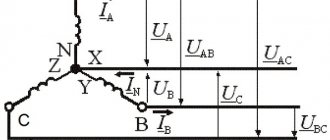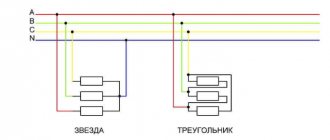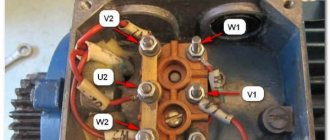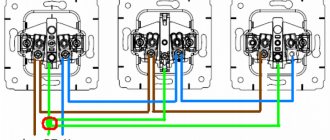How to reduce starting currents of an electric motor?
The phenomenon of a significant increase in inrush currents when starting high-power devices connected according to the Δ circuit leads in networks with overload to a short-term voltage drop below the permissible value. All this is explained by the special design of the asynchronous electric motor, in which the rotor with a large mass has high inertia. Therefore, at the initial stage of operation, the motor is overloaded, this is especially true for the rotors of centrifugal pumps, turbine compressors, fans, and machine tools.
To reduce the influence of all these electrical processes, they use a “star” and “delta” connection to the electric motor. When the engine picks up speed, the knives of a special switch (a starter with several three-phase contactors) transfers the stator windings from the Y circuit to the Δ circuit.
To implement mode changes, in addition to the starter, you need a special time relay, thanks to which there is a time delay of 50-100 ms when switching and protection against three-phase short circuits.
The very procedure of using the combined Y/Δ circuit effectively helps to reduce the inrush currents of powerful three-phase units. This happens as follows:
When a voltage of 660 V is applied according to the “triangle” circuit, each stator winding receives 380 V (√3 times less), and, therefore, according to Ohm’s law, the current strength decreases by 3 times. Therefore, when starting, the power in turn decreases by 3 times.
But such switching is possible only for motors with a rated voltage of 660/380 V when they are connected to a network with the same voltage values.
It is dangerous to connect an electric motor with a rated voltage of 380/220 V to a 660/380 V network; its windings can quickly burn out.
And also remember that the switching described above cannot be used for electric motors that have a load without inertia on the shaft, for example, the weight of a winch or the resistance of a piston compressor.
For such equipment, special three-phase electric motors with a wound rotor are installed, where rheostats reduce the value of currents during startup.
To change the direction of rotation of the electric motor, it is necessary to swap any two phases of the network for any type of connection.
For these purposes, when operating an asynchronous electric motor, special manual control electrical devices are used, which include reversing switches and batch switches or more modernized remote control devices - reversing electromagnetic starters (switches).
Phase and line voltages
To understand the differences between winding connection methods, you first need to understand the concepts of phase and line voltages. Phase voltage is the voltage between the beginning and end of one phase. Linear - between identical terminals of different phases.
For a three-phase network, linear voltages are the voltages between phases, for example, A and B, and phase voltages are between each phase and the neutral conductor.
So the voltages Ua, Ub, Uc will be phase, and Uab, Ubc, Uca will be linear. These voltages differ by several times. So, for a household and industrial network of 0.4 kV, linear voltages are 380 volts, and phase voltages are 220 volts.
Modular triangle
Despite the fact that the construction of crafts requires small blanks, to better master the assembly technique, it is preferable to use a wide-format sheet of paper.
When manufacturing the module, the following proportions between the sides must be observed - 1 to 1.5.
Order of steps:
- Fold the sheet in half, press the center line vertically and bend the ends to the middle basting.
- Unfold the workpiece on the other side and lift the edges-ears up;
- Bend the side corners through the main module.
- Straighten the product, fold small triangles along the lines, lift the edges up. Fold the base in half. An element with two corners and pockets should come out.
If you make a lot of such modules, then you can assemble quite interesting things from them, for example, a fairy-tale dragon.
Triangle from A4 sheet
This figurine is one of the simplest variations. Paper and scissors are all you need to make it. How to make a triangle from A4 sheet:
Place a sheet of paper in front of you. Fold the top corner diagonally. Gently move your hand, smoothing. We don't need the strip - we cut it off.
We unfold the workpiece and cut it into two parts along the fold line. You should end up with two isosceles triangles.
Do you need smaller shapes? We bend the base in half as many times as necessary to get the figures of the required size.
If you use green, yellow or some other paper instead of white, the triangles will be colorful and fun.











